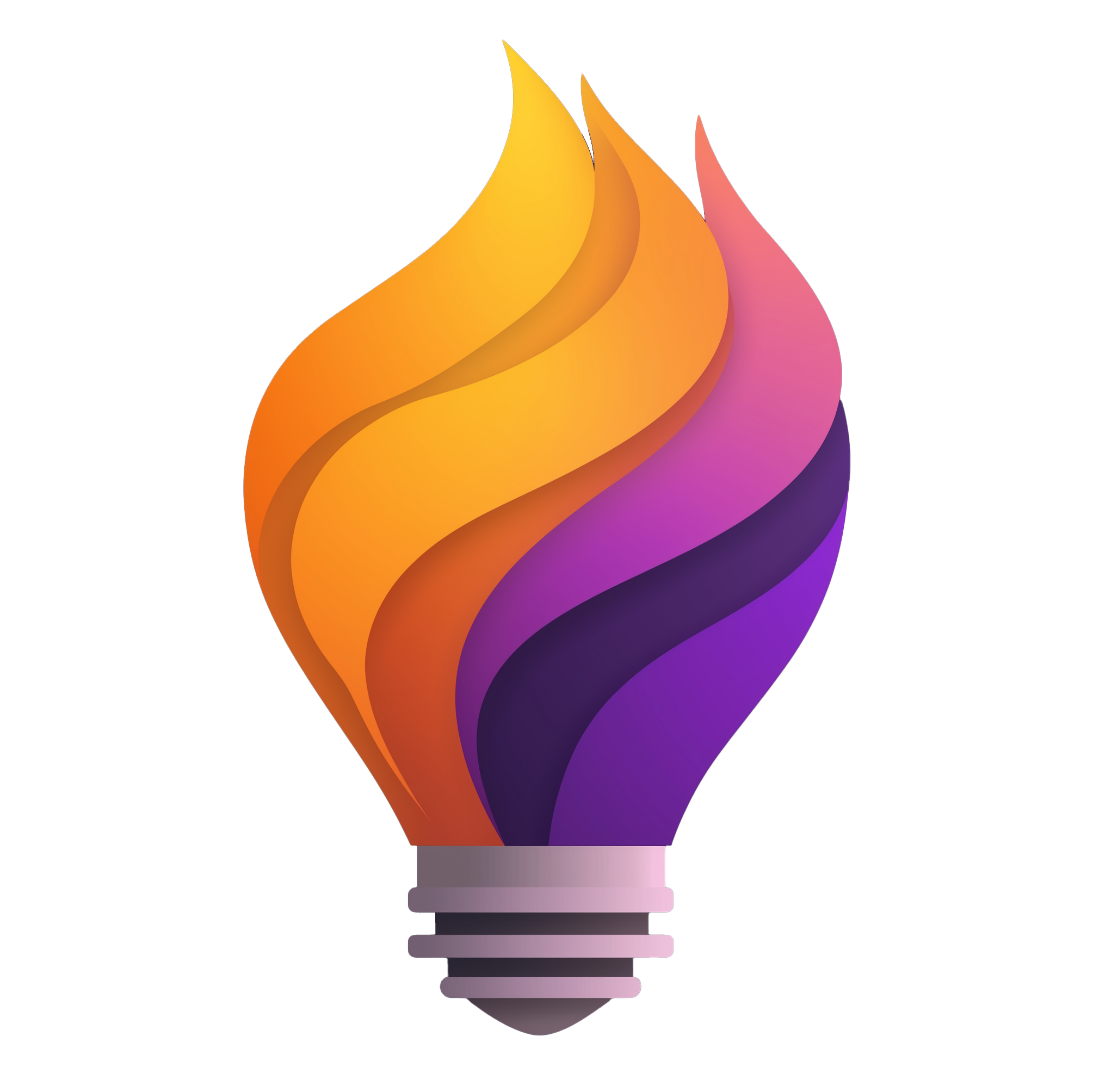From choosing a new software vendor to pivoting your entire business model, the quality of your decisions directly shapes your success. Yet, many teams rely on gut feelings or endless debates, leading to analysis paralysis or costly mistakes. Structured decision-making frameworks provide a clear path forward, transforming complex problems into manageable steps. They remove bias, clarify priorities, and align everyone toward a common goal, which is especially critical for remote and distributed teams where clear communication is paramount.
This article presents a curated list of ten powerful frameworks designed to bring clarity and confidence to your choices. We will move beyond theory and provide actionable steps, best-use scenarios, and practical examples for each model, from SWOT Analysis to the OODA Loop. You’ll learn how to select the right tool for your specific challenge, whether you’re making a quick tactical choice or a long-term strategic one. For those specifically interested in applying structured approaches to business development, explore various product strategy frameworks to complement these general models. By the end of this guide, you will have a versatile toolkit to help your team navigate uncertainty and make consistently better, data-informed decisions.
1. SWOT Analysis
SWOT Analysis is a classic strategic planning tool that helps teams and individuals make informed decisions by evaluating four key elements: Strengths, Weaknesses, Opportunities, and Threats. This framework provides a structured, 360-degree view of both internal factors (Strengths, Weaknesses) and external factors (Opportunities, Threats) that can influence the outcome of a project or business venture.
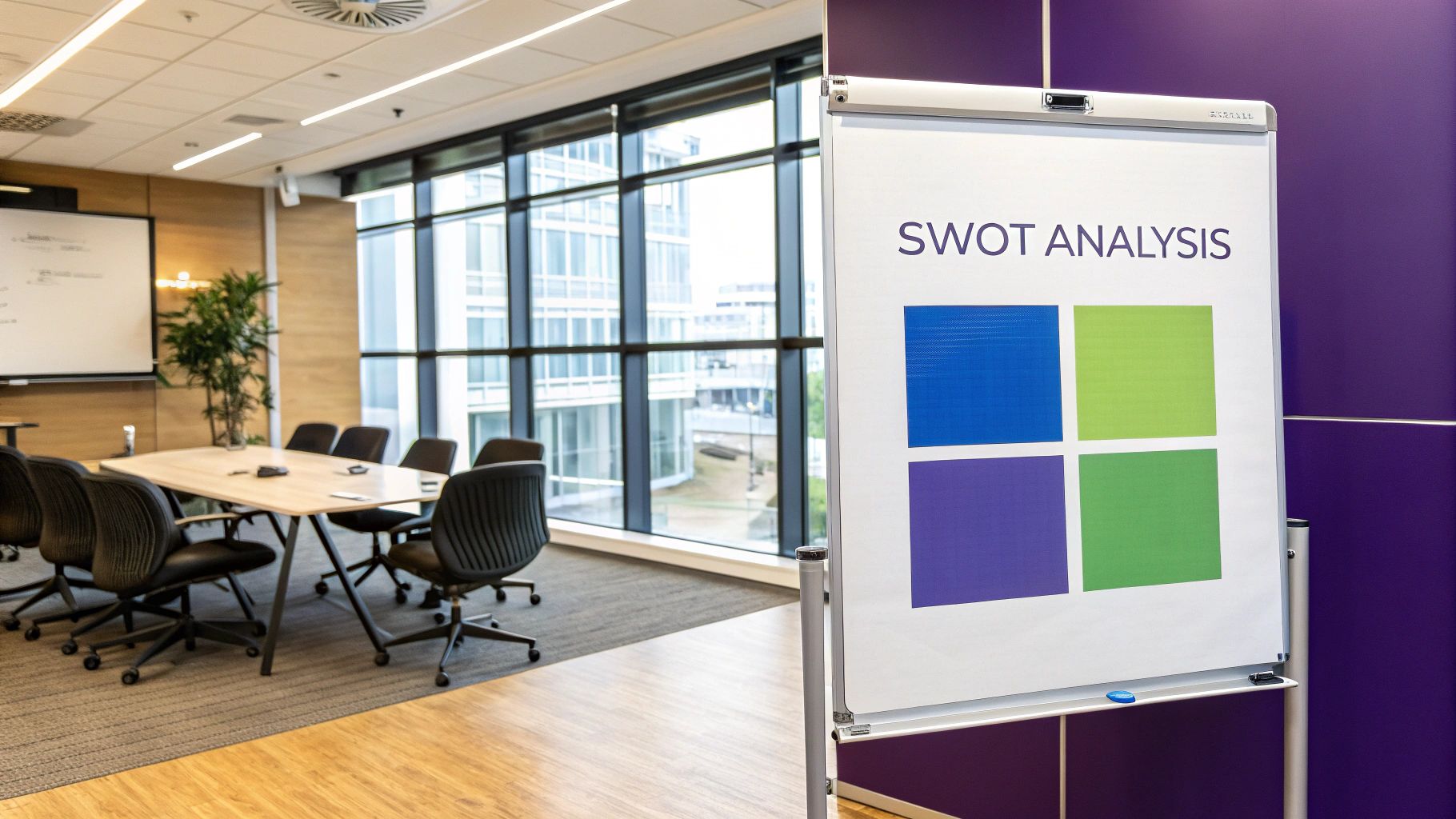
This method organizes complex information into a simple four-quadrant grid, making it one of the most accessible decision making frameworks available. By mapping out these areas, teams can identify what they do well, where they need to improve, how they can leverage market conditions, and what risks they need to mitigate.
When to Use SWOT Analysis
SWOT is incredibly versatile, making it ideal for high-level strategic planning sessions, evaluating a new business idea, or assessing a potential career change. For example, Netflix famously used this type of analysis when shifting from DVDs to streaming. Their strength was their large subscriber base, a weakness was their reliance on mail, the opportunity was emerging internet speeds, and the threat was new competitors. This clarity helped guide their monumental transition.
How to Implement SWOT Analysis for Remote Teams
For distributed teams, conducting a SWOT analysis can be a powerful collaborative exercise.
- Use a Digital Whiteboard: Tools like Miro or Mural allow everyone to contribute to a shared SWOT grid in real-time. Assign a different color sticky note to each team member to track contributions.
- Involve Diverse Roles: Invite members from different departments (engineering, marketing, sales) to get a well-rounded view. A developer might identify a technical strength, while a salesperson might highlight a market opportunity others missed.
- Be Specific: Instead of a vague weakness like “poor communication,” specify it as “delayed responses on cross-departmental Slack channels.” This makes the problem actionable.
- Turn Insights into Action: A SWOT analysis is a starting point. Use the findings to create a concrete action plan. For example, how can you use a strength to seize an opportunity? How will you minimize a weakness to avoid a threat?
2. Cost-Benefit Analysis (CBA)
Cost-Benefit Analysis (CBA) is a systematic and quantitative framework used to evaluate a decision by comparing its total projected costs against its total projected benefits. By assigning a monetary value to every factor, both tangible and intangible, CBA provides a clear, data-driven basis for determining if a potential action is financially sound and will yield a positive return.
This method boils complex decisions down to a simple question: Do the benefits outweigh the costs? It’s one of the most powerful decision making frameworks for choices with significant financial implications. The goal is to translate all potential outcomes into a common currency, allowing for a straightforward comparison of different options.
When to Use Cost-Benefit Analysis
CBA is exceptionally useful for major investment decisions where resources are limited and justification is critical. For instance, a corporation deciding whether to implement a new company-wide IT system would use CBA to weigh the software license fees, training expenses, and implementation downtime (costs) against the expected efficiency gains, reduced errors, and improved data security (benefits). It’s also standard practice for government infrastructure projects, like building a new highway, to ensure public funds are used effectively.
How to Implement Cost-Benefit Analysis for Remote Teams
Applying CBA in a distributed environment requires a structured, collaborative approach to ensure accuracy.
- Brainstorm Costs and Benefits Inclusively: Use a shared spreadsheet or project management tool to create two lists: one for all potential costs and one for all potential benefits. Invite team members from finance, operations, and technical departments to contribute, as they will identify factors others might miss.
- Assign Monetary Values Conservatively: Quantify every item on your lists. For intangible benefits like “improved team morale,” estimate its value through proxies like reduced employee turnover costs. When values are uncertain, use conservative estimates to avoid overly optimistic projections.
- Account for Time: Calculate the payback period and consider the net present value (NPV) to account for the time value of money. A benefit received five years from now is worth less than the same benefit received today.
- Conduct a Sensitivity Analysis: Identify the most uncertain variables and recalculate the outcome using different values (optimistic, pessimistic, and expected). This tests how sensitive your decision is to your assumptions and helps mitigate the influence of cognitive bias in decision making.
3. Decision Matrix (Weighted Scoring)
A Decision Matrix is a systematic approach for evaluating multiple alternatives against a set of criteria. Also known as a weighted scoring model, it removes emotion from the equation by assigning a numerical weight to each criterion based on its importance, allowing for a quantitative comparison that points to the most logical choice.
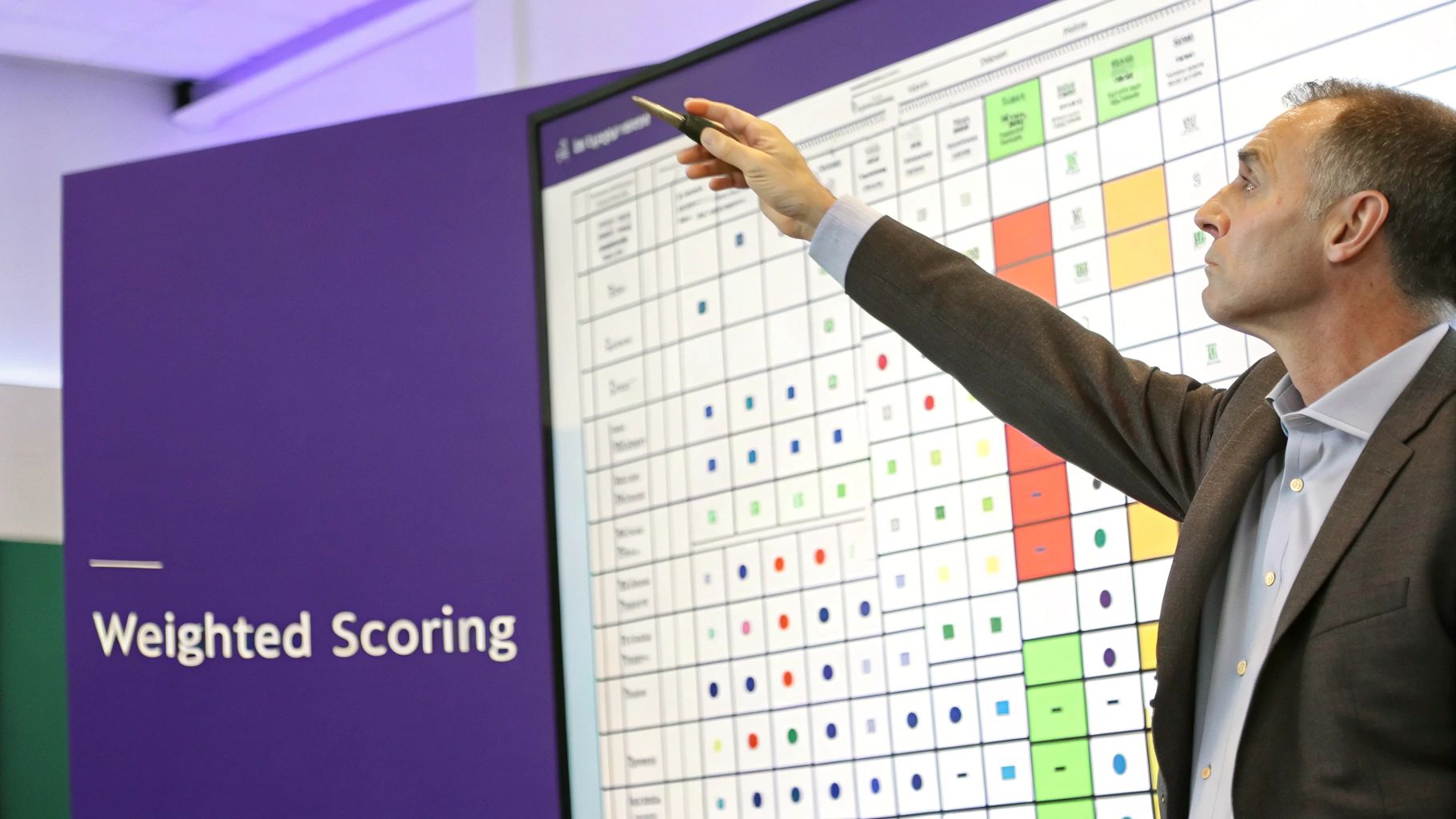
This method organizes complex choices into a clear, grid-based table, making it one of the most transparent decision making frameworks for complex problems. By scoring each option against predefined criteria and multiplying by the weight, you get a final score that makes the best path forward objectively clear. This method is a core component of many structured problem-solving techniques on remotesparks.com.
When to Use a Decision Matrix
A Decision Matrix is perfect for high-stakes decisions with multiple competing options and variables, like choosing a new software vendor or prioritizing product features for the next development cycle. For instance, when hiring a key employee, criteria might include experience (weight: 40%), culture fit (weight: 30%), and technical skills (weight: 30%). Each candidate is scored on these points, and the weighted total reveals the strongest applicant.
How to Implement a Decision Matrix for Remote Teams
For distributed teams, a Decision Matrix ensures alignment and provides a documented rationale for important choices.
- Use a Shared Spreadsheet: Tools like Google Sheets or Airtable are perfect for building a collaborative decision matrix. Everyone can see the criteria, weights, and scores in real-time.
- Define Criteria and Weights Together: Hold a video call to collectively define what success looks like. Gaining stakeholder buy-in on the criteria and their respective weights is crucial for the final decision to be accepted by the team.
- Keep Scoring Consistent: Use a simple, agreed-upon scale (e.g., 1-5 or 1-10) for scoring each option. Provide clear definitions for what each number represents to avoid subjective interpretations.
- Validate the Outcome: After calculating the final scores, discuss the result. Does the winning option “feel” right? If not, it may indicate that a key criterion was missed or a weight was misjudged, prompting a valuable final review.
4. Pareto Analysis (80/20 Rule)
Pareto Analysis, also known as the 80/20 Rule, is a powerful framework that helps prioritize tasks by identifying the vital few inputs that produce the most significant results. The principle states that roughly 80% of effects come from 20% of the causes. This model helps teams focus their limited resources on the areas that will yield the greatest impact.
This method helps cut through the noise of competing priorities by using data to highlight what truly matters. It’s one of the most effective decision making frameworks for improving productivity and efficiency. By concentrating on the critical 20% of factors, teams can solve major problems and capitalize on key opportunities without getting bogged down by less important issues.
When to Use Pareto Analysis
Pareto Analysis is ideal for identifying the root causes of problems, prioritizing product features, or optimizing resource allocation. For example, Microsoft famously uses this approach to prioritize bug fixes by focusing on the 20% of bugs that cause 80% of software crashes. This ensures their development efforts deliver the most value to users. Similarly, a sales team might find that 80% of its revenue comes from 20% of its clients, guiding its customer relationship strategy.
How to Implement Pareto Analysis for Remote Teams
Applying the 80/20 rule can bring sharp focus to a distributed team’s efforts.
- Gather Your Data: Before you can analyze, you need data. Collect information on customer complaints, software bugs, sales figures, or project delays. Use shared spreadsheets or project management tools to centralize this information.
- Identify and Group Causes: Work together on a video call or asynchronously in a shared document to categorize the problems. For instance, group customer support tickets by issue type (e.g., billing, login, feature request).
- Visualize with a Pareto Chart: Create a simple bar chart showing the frequency of each cause, ordered from highest to lowest. A cumulative percentage line helps visualize the 80/20 split. This visual makes it easy for everyone to see which issues are the most critical.
- Focus on the Vital Few: Once you identify the top 20% of causes, create an action plan to address them. This ensures your team’s efforts are concentrated on high-impact work, not just busy work.
5. Six Thinking Hats
Six Thinking Hats is a powerful parallel thinking framework developed by Edward de Bono. It guides individuals and groups to look at a decision from six distinct perspectives, each represented by a metaphorical colored hat. This method systematically separates emotion from fact and creativity from risk analysis, fostering comprehensive thinking while minimizing conflict.
This framework structures conversations so that everyone focuses on the same perspective at the same time, preventing unproductive debates. By “wearing” each hat together, teams can explore a problem thoroughly, making it one of the most effective decision making frameworks for collaborative problem-solving and innovation. The six hats are: White (facts), Red (emotions), Black (cautions), Yellow (benefits), Green (creativity), and Blue (process).
When to Use Six Thinking Hats
This method is ideal for complex problems where diverse viewpoints and potential conflicts could derail a meeting. It is used extensively in product development, strategic planning, and policy creation. For instance, a product team at Motorola might use the hats to evaluate a new feature. They would start with the White Hat to review user data, then the Yellow Hat to brainstorm benefits, followed by the Black Hat to identify potential risks, ensuring a balanced and holistic evaluation.
How to Implement Six Thinking Hats for Remote Teams
Facilitating a Six Thinking Hats session remotely requires clear structure and engagement.
- Appoint a Facilitator (Blue Hat): Designate one person to manage the process, keep time, and ensure the team stays focused on the current hat. This person acts as the “Blue Hat” for the entire session.
- Use Visual Cues: On a shared digital whiteboard like Miro, create sections for each hat using its corresponding color. As the team discusses each perspective, capture notes in the designated area.
- Timebox Each Hat: Allocate a specific amount of time for each hat (e.g., 5-10 minutes) to keep the discussion moving and prevent getting bogged down in one mode of thinking.
- Document and Synthesize: After going through the hats, the facilitator should summarize the key insights from each perspective. This summary provides a clear, multi-faceted foundation for making a final, well-rounded decision.
6. Cynefin Framework
The Cynefin Framework, developed by Dave Snowden, is a conceptual tool that helps leaders understand the context of their problems before deciding on a course of action. It categorizes situations into five distinct domains: Simple, Complicated, Complex, Chaotic, and a central space of Disorder. This framework prevents the common mistake of applying one-size-fits-all solutions to varied challenges.
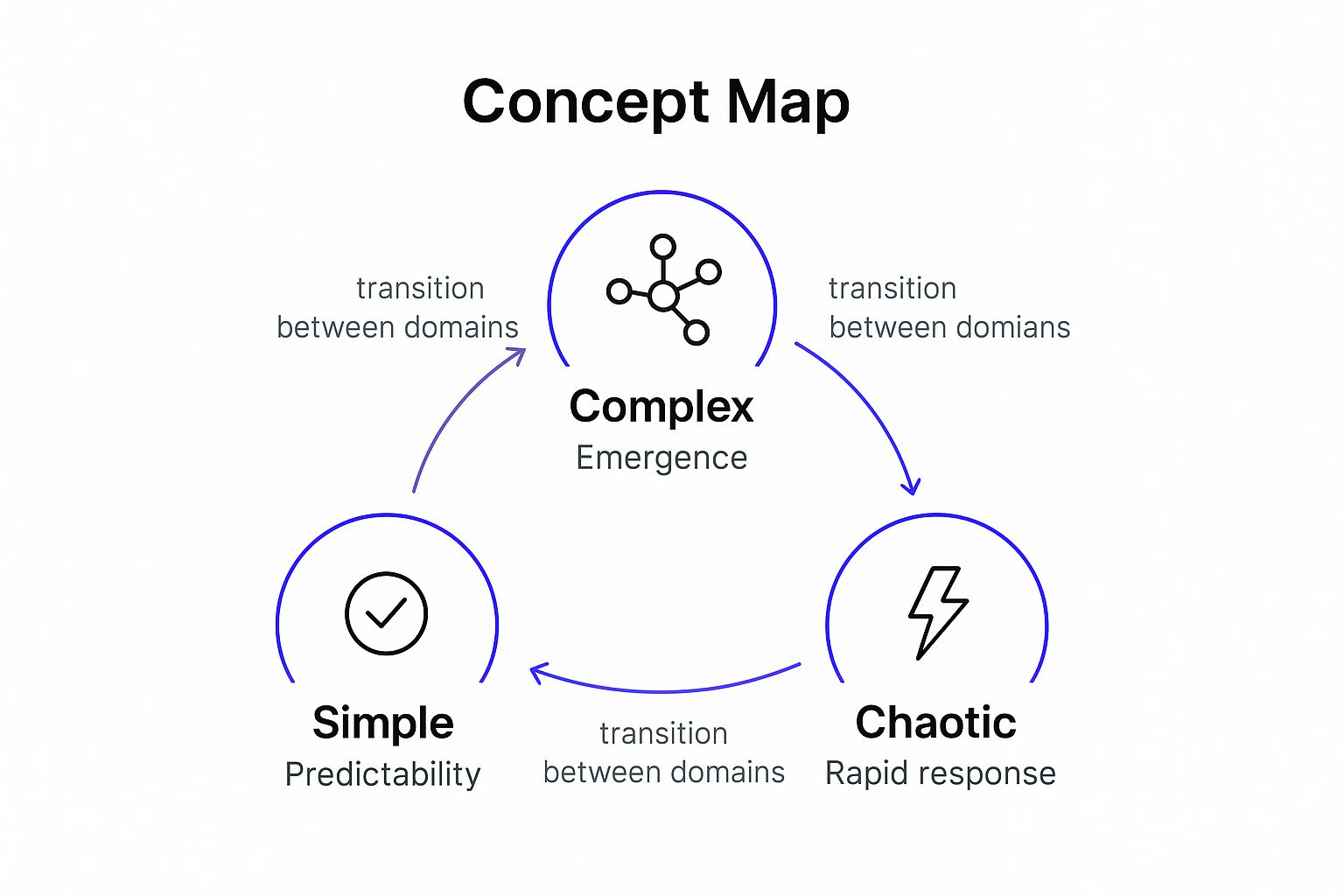
Unlike traditional grids, Cynefin is one of the most dynamic decision making frameworks because it acknowledges that situations can shift between domains. The infographic above illustrates the relationships between the Simple, Complex, and Chaotic domains, highlighting the different response patterns each requires. Understanding these transitions is key, as a stable situation can quickly become chaotic if mismanaged.
When to Use the Cynefin Framework
The Cynefin Framework is invaluable during strategic planning, crisis management, or when leading projects with high uncertainty, like in Agile software development. For example, a healthcare system responding to a pandemic would use it to differentiate problems. Administering known vaccines falls into the Complicated domain (requiring experts), while understanding the virus’s initial community spread is Complex (requiring experiments). A sudden, overwhelming surge in cases would be Chaotic, demanding rapid, decisive action.
How to Implement the Cynefin Framework for Remote Teams
For distributed teams facing multifaceted challenges, this framework provides a shared language to diagnose problems accurately.
- Start by Diagnosing the Domain: Begin any major project or problem-solving session by collectively deciding which domain the situation fits into. Is there a clear best practice (Simple), or do you need to experiment and learn (Complex)?
- Use Experts for Complicated Problems: If a problem is Complicated, with known unknowns, bring in subject matter experts. A remote team might consult a cybersecurity specialist for a data breach, rather than guessing at solutions.
- Run Safe-to-Fail Experiments for Complex Issues: For Complex problems, where cause and effect are only clear in hindsight, run small, controlled experiments. An A/B test for a new app feature is a perfect example of probing a complex system to see what emerges.
- Be Prepared to Shift: Situations evolve. A well-managed project (Complicated) might face a sudden server outage, throwing it into Chaos. Teams must be ready to adapt their approach, moving from analysis to immediate action.
7. OODA Loop
The OODA Loop is a high-speed decision-making framework designed for rapid, iterative cycles of learning and adaptation. Developed by military strategist Colonel John Boyd, it consists of four stages: Observe, Orient, Decide, and Act. This model isn’t a linear checklist but a continuous loop, emphasizing that the ability to process information and react faster than an opponent is a decisive advantage.
Its power comes from focusing on the Orient phase, which involves analyzing new information in the context of your existing knowledge to create a mental model of the situation. By quickly cycling through the loop, teams can seize the initiative in fast-changing environments, making it one of the most agile decision making frameworks for competitive markets.
When to Use the OODA Loop
The OODA Loop is invaluable in volatile, uncertain, and competitive situations where speed is critical. It’s perfect for startups needing to pivot quickly, cybersecurity teams responding to threats, or product teams iterating on features based on user feedback. For instance, Tesla’s famously rapid product development cycles embody the OODA Loop. They observe market trends and manufacturing data, orient their strategy around innovation, decide on design changes, and act to implement them on the factory floor almost immediately.
How to Implement the OODA Loop for Remote Teams
For remote teams, implementing this framework requires a commitment to speed and clear communication channels.
- Invest in Real-Time Data: Use dashboards and analytics tools to ensure everyone can observe the same critical information simultaneously, from customer support tickets to server performance metrics.
- Establish Shared Context: The orient phase is crucial. Use shared documents or a team wiki to maintain a collective understanding of goals and past experiences. This helps team members make sense of new data quickly.
- Empower Small, Quick Decisions: Don’t let decisions get stuck in a hierarchical bottleneck. Empower team members to decide and act on issues within their domain, trusting them to operate within the shared context.
- Create Tight Feedback Loops: After every action, immediately circle back to observe the outcome. Use dedicated Slack channels or quick video huddles to review results and kick off the next loop, ensuring the cycle is continuous and responsive.
8. Analytic Hierarchy Process (AHP)
The Analytic Hierarchy Process (AHP) is a structured mathematical framework for tackling complex decisions. Developed by Thomas Saaty, it breaks a problem down into a hierarchy of more easily understood parts: the goal, the criteria for judgment, and the alternatives available. This method then uses pairwise comparisons to quantify the importance of each element, making it one of the most rigorous decision making frameworks for choices with multiple conflicting criteria.
AHP translates subjective assessments into numerical values, allowing for a more objective comparison of different options. By organizing the decision into a logical structure and evaluating pairs of elements (e.g., is “Cost” more important than “User Experience”?), teams can systematically determine which alternative best aligns with their overall goal. This provides a clear, rational justification for the final choice.
When to Use AHP
AHP shines when decisions are complex, have long-term consequences, and involve multiple stakeholders with different priorities. It is heavily used in corporate strategic planning and government contractor selection, where a transparent and defensible process is critical. For instance, a healthcare system might use AHP to decide which new medical equipment to purchase by comparing alternatives based on criteria like cost, patient outcomes, and ease of use.
How to Implement AHP for Remote Teams
While mathematically intensive, AHP can be managed effectively by distributed teams using the right approach.
- Use Specialized Software: AHP’s complexity makes spreadsheets cumbersome. Use dedicated software like AHP-OS or TransparentChoice to manage the pairwise comparisons and automatically calculate weights and consistency ratios.
- Establish Criteria Collaboratively: Use a virtual workshop to define the decision criteria. Ensure everyone agrees on what makes a successful outcome before starting comparisons.
- Check for Consistency: A key feature of AHP is the consistency ratio, which checks for contradictions in judgment (e.g., if A > B and B > C, then A must be > C). Regularly check this metric to ensure the inputs are logical and reliable.
- Validate with Stakeholders: Once the analysis is complete, present the results and the hierarchy to key stakeholders. This transparency builds buy-in and confirms the model accurately reflects organizational priorities.
9. Scenario Planning
Scenario Planning is a strategic foresight tool that prepares organizations for an uncertain future by creating multiple plausible narratives of what might happen. Instead of trying to predict one single outcome, this framework explores several distinct, alternative futures and evaluates how decisions would perform across all of them. This method was famously refined by Royal Dutch Shell to navigate the oil crises of the 1970s.
This approach moves beyond simple forecasting by embracing uncertainty, making it one of the most robust decision making frameworks for long-term strategic planning. By considering a range of possibilities, from best-case to worst-case scenarios, teams can develop more resilient and adaptable strategies that are less likely to be derailed by unexpected events.
When to Use Scenario Planning
Scenario Planning is invaluable when making high-stakes decisions with long-term consequences in a volatile environment. It’s used by organizations for everything from climate change adaptation strategies and military planning to navigating major market shifts. For example, a tech company might use it to plan for different regulatory futures, such as new data privacy laws or international trade restrictions, ensuring its business model remains viable regardless of which future unfolds.
How to Implement Scenario Planning for Remote Teams
For distributed teams, Scenario Planning fosters alignment on long-term strategy amidst global uncertainty.
- Identify Key Driving Forces: Start by brainstorming the major trends and uncertainties that could impact your business, like technological advancements, regulatory changes, or shifting consumer behaviors. Use a shared document or virtual whiteboard to collect these ideas.
- Develop 3-4 Plausible Scenarios: Group the driving forces into 3-4 distinct but plausible future worlds. Give each scenario a memorable name, like “Tech Utopia,” “Regulatory Clampdown,” or “Economic Stagnation.”
- Stress-Test Your Strategy: Have cross-functional team members discuss how your current strategy would fare in each scenario. What works? What breaks? Use video conferencing breakout rooms for smaller group discussions.
- Identify Robust Actions and Signposts: Conclude by defining actions that would be beneficial across most or all scenarios. Also, establish “signposts” or early indicators that will help you recognize which scenario is beginning to materialize, allowing you to adapt quickly.
10. Design Thinking Process
The Design Thinking Process is a human-centered, iterative framework that focuses on understanding users, challenging assumptions, and redefining problems to identify alternative strategies and solutions. It’s not just for designers; it’s a powerful method for any team aiming to solve complex problems by prioritizing user needs. The process generally follows five stages: Empathize, Define, Ideate, Prototype, and Test.
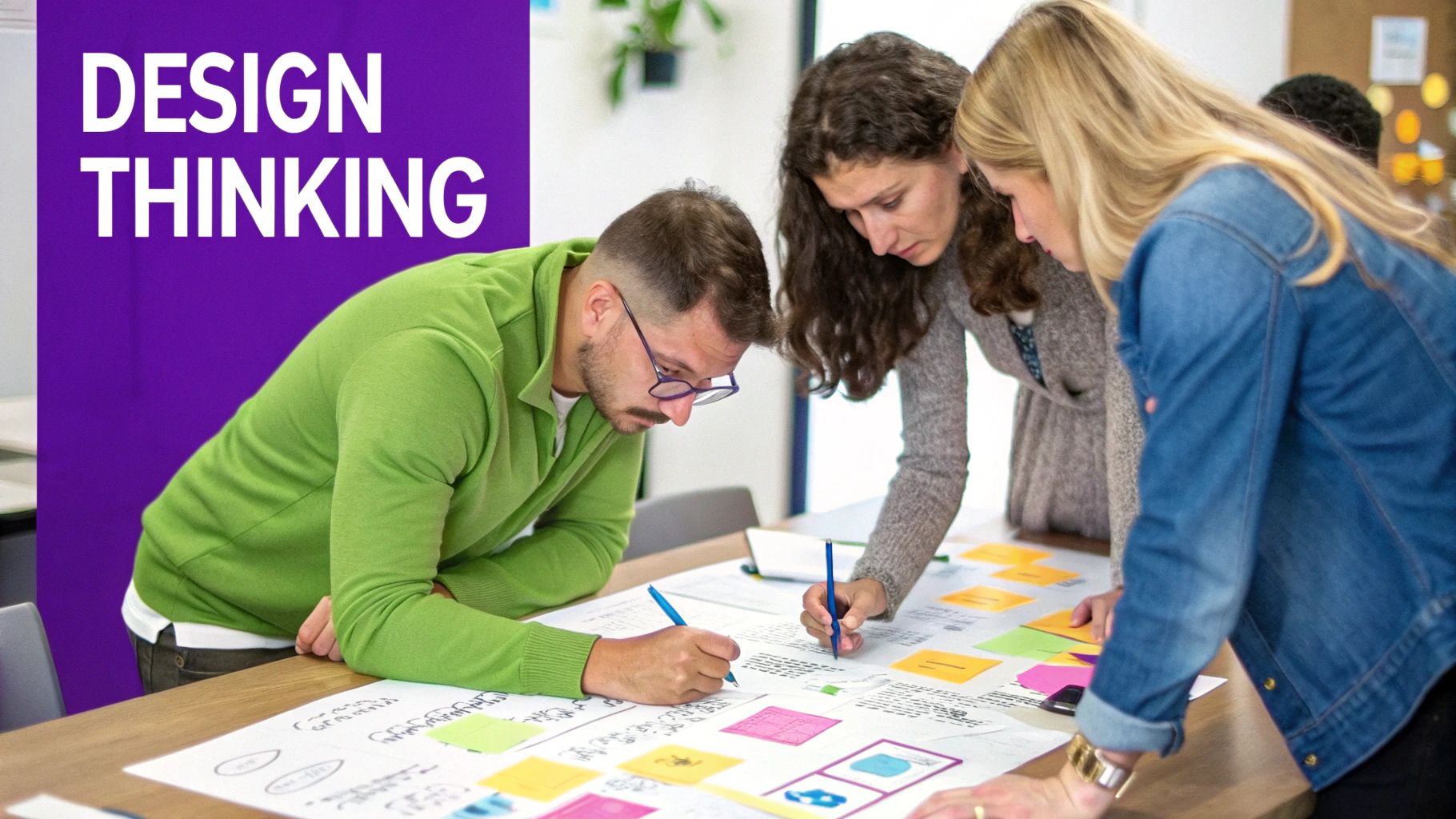
This approach transforms how organizations develop products, services, and processes. By placing the user at the heart of the decision-making journey, it ensures the final output is not only functional but truly desirable. It stands out among decision making frameworks for its creative, hands-on, and empathetic nature.
When to Use the Design Thinking Process
Design Thinking is ideal when tackling problems that are ill-defined or unknown. It excels in product innovation, service improvement, and enhancing user experience. For instance, Airbnb used this process to revitalize its business. By empathizing with hosts, they discovered that low-quality photos were a major issue. Their solution, professional photography, came directly from understanding user pain points, not from a spreadsheet.
How to Implement the Design Thinking Process for Remote Teams
Adopting this user-centric framework is highly effective for distributed teams looking to innovate.
- Invest in Digital Empathy Tools: Use video interviews, online surveys, and user session recording tools like FullStory to deeply understand user behaviors and motivations without being physically present.
- Host Virtual Ideation Sessions: Leverage digital whiteboards for collaborative brainstorming during the Ideate stage. To explore this further, you can learn more about ideation frameworks. Encourage a “yes, and…” mindset to build on ideas without judgment.
- Prototype Rapidly with Digital Tools: Use tools like Figma or InVision to create and share interactive prototypes quickly. This allows the team to gather feedback from real users early and often, regardless of location.
- Embrace Asynchronous Testing: Conduct user testing asynchronously through platforms that allow users to record their screens and voice their thoughts as they interact with a prototype on their own time.
Decision-Making Frameworks Comparison Table
| Method | Implementation Complexity 🔄 | Resource Requirements ⚡ | Expected Outcomes 📊 | Ideal Use Cases 💡 | Key Advantages ⭐ |
|---|---|---|---|---|---|
| SWOT Analysis | Low – Simple framework, qualitative | Low – Team input, minimal tools | Broad situational awareness, clear factor visualization | Strategic planning, competitive analysis, personal/business decisions | Easy to understand; encourages internal & external view; fosters collaboration |
| Cost-Benefit Analysis | Medium – Requires data and quantitative modeling | Medium to High – Data gathering & financial analysis | Objective, monetary-based decision justification | Investment decisions, policy analysis, resource allocation | Numerical basis; compares alternatives; uncovers hidden costs/benefits |
| Decision Matrix (Weighted Scoring) | Medium – Needs criteria weighting and scoring | Medium – Stakeholder involvement, scoring process | Prioritized alternatives based on weighted criteria | Complex decisions with multiple factors and options | Systematic multi-criteria evaluation; reduces bias; transparent |
| Pareto Analysis (80/20) | Low – Simple statistical principle | Low – Data collection and charting | Focused prioritization on vital few factors | Priority setting, problem-solving, resource optimization | Easy to communicate; effective focus; resource-efficient |
| Six Thinking Hats | Medium – Structured group process | Medium – Facilitator, participant engagement | Comprehensive perspectives, reduced conflicts | Group decision-making, creative problem-solving, strategic planning | Covers diverse viewpoints; reduces ego conflicts; fosters creativity |
| Cynefin Framework | High – Abstract, requires training and experience | Medium – Experienced leaders, contextual analysis | Tailored decision approach aligned to problem type | Leadership decisions, crisis management, uncertainty navigation | Matches approach to context; acknowledges complexity and emergence |
| OODA Loop | Medium – Iterative rapid process | Medium – Speedy info processing and feedback loops | Fast, adaptive decisions in dynamic environments | Competitive environments, crisis response, tactical decisions | Promotes agility; builds situational awareness; quick response |
| Analytic Hierarchy Process (AHP) | High – Complex mathematical hierarchy and pairwise comparisons | High – Training and specialized software/tools | Consistent, rigorous ranking of multi-criteria options | Complex multi-criteria decisions needing mathematical rigor | Mathematical rigor; handles complexity; supports group decisions |
| Scenario Planning | High – Developing multiple detailed futures | High – Time, creativity, data, facilitation | Robust strategies resilient across scenarios | Strategic, long-term decisions, uncertainty management | Prepares for uncertainty; improves strategic thinking; reduces surprises |
| Design Thinking Process | Medium – Iterative, human-centered stages | Medium – User research, prototyping resources | Innovative, user-focused problem solutions | Innovation, product development, user experience challenges | User-centric; fosters creativity; reduces risk through testing |
From Frameworks to Forward Motion: Mastering Your Next Decision
Navigating the landscape of choice, whether for a startup’s pivotal next move or a product team’s feature prioritization, can feel overwhelming. Throughout this guide, we’ve explored a powerful arsenal of ten distinct decision making frameworks, moving from the foundational SWOT Analysis and Cost-Benefit Analysis to the more dynamic OODA Loop and the context-aware Cynefin Framework. We’ve seen how each model offers a unique lens through which to view a problem, providing structure and clarity where there might otherwise be chaos.
The core lesson is not to find a single “perfect” framework, but to build a versatile toolkit. The true power lies in understanding which tool to deploy for a specific situation. A simple, low-risk choice might only need a quick Pareto Analysis, while a complex, uncertain strategic direction could benefit immensely from the structured exploration of Scenario Planning or the collaborative creativity of the Six Thinking Hats. For remote teams, these frameworks are more than just abstract models; they are communication protocols that create shared understanding and alignment across distances.
Your Actionable Path to Better Decisions
Mastering these concepts is a journey of practical application. Don’t let this knowledge remain theoretical. Your next step is to consciously integrate these frameworks into your workflow, transforming abstract ideas into concrete outcomes.
Here’s how you can start today:
- Identify Your Next Small Decision: Pick a low-stakes decision your team needs to make this week. It could be choosing a new software tool or deciding on the focus for the next sprint.
- Select a Simple Framework: Apply a straightforward model like a Decision Matrix. List your criteria, weight them, score your options, and see where the data leads you. The goal is to practice the process.
- Facilitate a Team Discussion: For a more complex issue, try facilitating a session using the Six Thinking Hats. This structured approach ensures all perspectives are heard, which is especially valuable in a remote or hybrid setting.
- Reflect and Iterate: After the decision is made, briefly discuss with your team how the framework helped (or didn’t). Did it clarify the options? Did it prevent circular conversations? This feedback loop is crucial for improvement.
Ultimately, the value of these decision making frameworks extends far beyond simply picking Option A over Option B. They cultivate a culture of critical thinking, data-informed reasoning, and intentionality. By adopting these structured approaches, you empower your team to move from analysis paralysis to decisive action, building momentum and driving meaningful progress with confidence. The best decision you can make right now is to start practicing.
Ready to put these frameworks into action with a tool built for collaborative innovation? Bulby provides the structured environment your team needs to apply methods like Design Thinking and Scenario Planning, turning your best ideas into actionable projects. Start making smarter, faster decisions together at Bulby.
